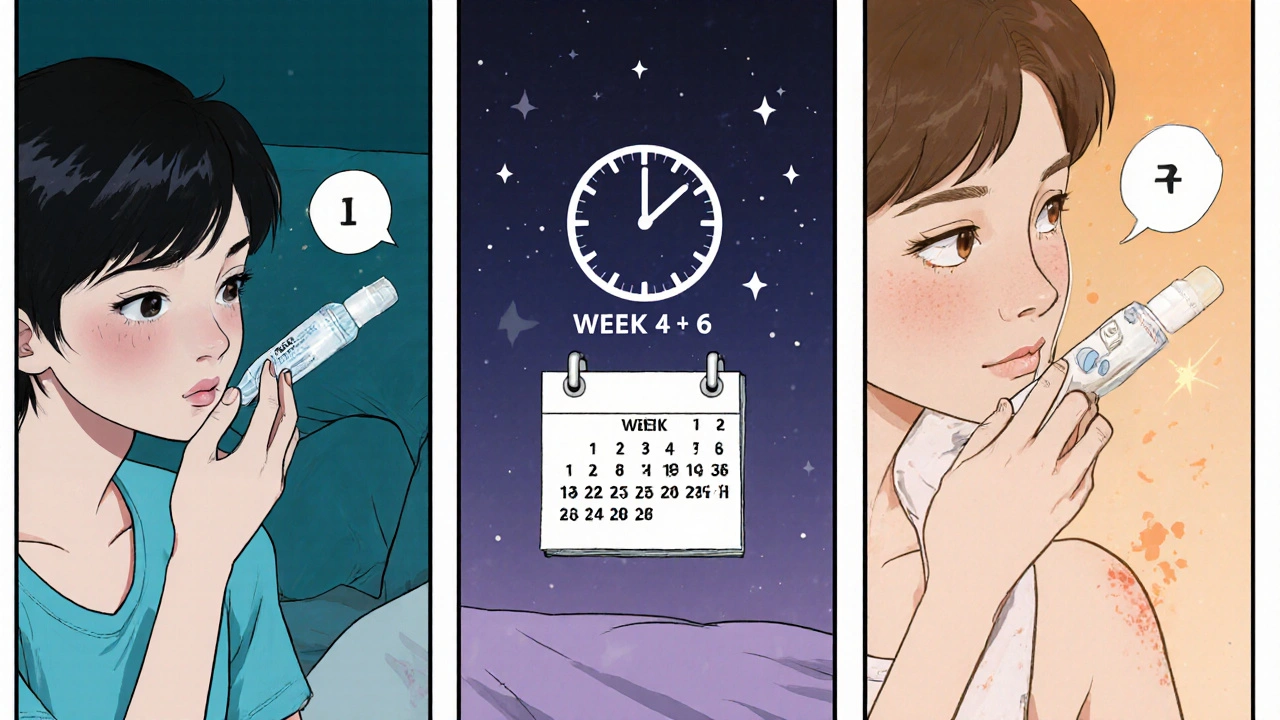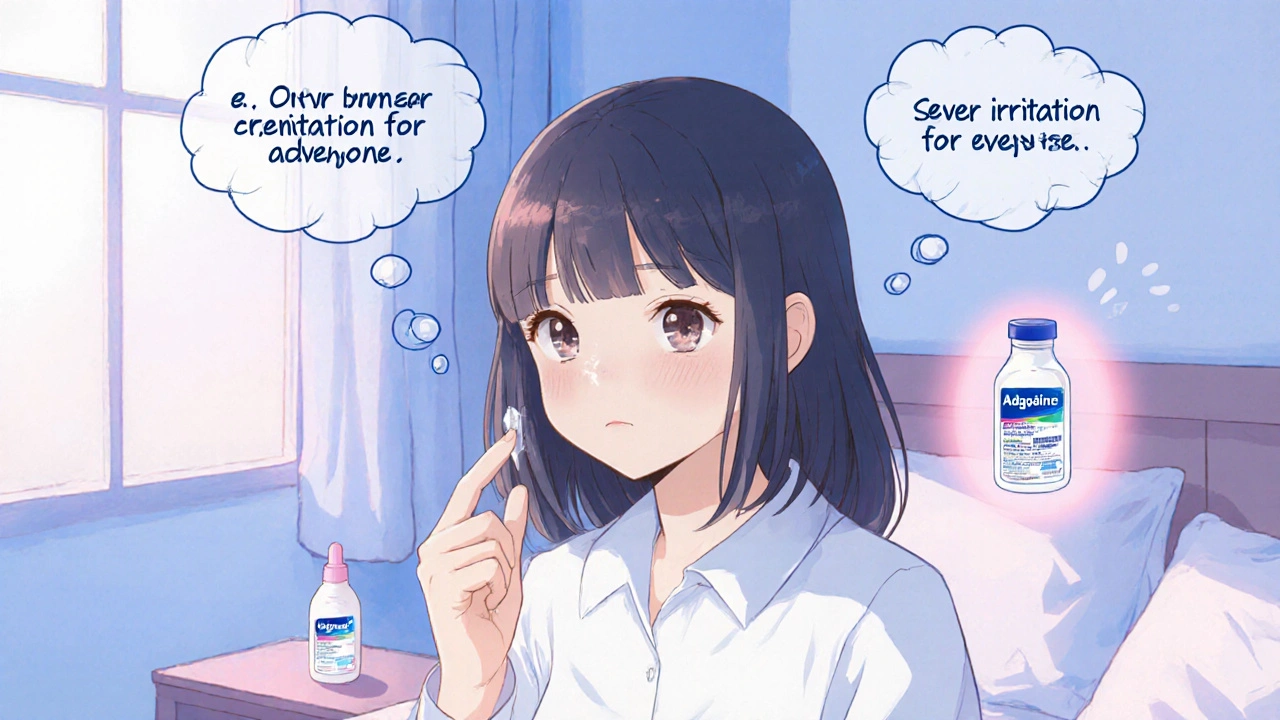Adapalene Treatment Timeline Calculator
See how your acne might improve with consistent Adapalene use based on clinical study data. This tool uses data from a 2022 double-blind study with 1,200 participants showing 40% reduction in inflammatory lesions after 12 weeks of nightly use.
When it comes to acne, Adapalene is a third‑generation retinoid that helps unclog pores, lower inflammation, and improve skin texture. Over the past few years it’s gone from a prescription‑only product to a staple on many over‑the‑counter shelves, and along the way a lot of misinformation has piled up. This guide cuts through the hype, backs up each claim with real data, and shows you how to get the most out of the gel without unnecessary fear.
What Is Adapalene?
Adapalene belongs to the Retinoid family, a class of vitamin‑A derivatives that speed up cell turnover. Unlike older retinoids, it’s designed to be gentler on the skin, making it a popular first‑line therapy for mild to moderate acne. Clinical trials (e.g., a 2022 double‑blind study involving 1,200 participants) showed a 40 % reduction in inflammatory lesions after 12 weeks of nightly use.
Common Myths About Adapalene
- Myth 1: It’s only for severe acne.
- Myth 2: It causes severe skin irritation for everyone.
- Myth 3: You can’t combine it with other acne products.
- Myth 4: You must wait months before seeing any improvement.
- Myth 5: It’s the same as prescription‑only retinoids like isotretinoin.
Fact Check - Evidence Behind Each Claim
| Myth | Fact |
|---|---|
| Only for severe acne | Effective for mild to moderate acne; works best on comedonal and inflammatory lesions. |
| Causes severe irritation for everyone | Most users experience mild dryness or redness; severe reactions occur in <5 % of cases and are usually mitigated by proper moisturising. |
| Can’t combine with other products | Can be paired with Benzoyl Peroxide or Salicylic Acid if introduced gradually. |
| Results take months | Visible improvement often appears after 4‑6 weeks; optimal results seen at 12 weeks. |
| Same as isotretinoin | Isotretinoin is a systemic oral retinoid for severe cystic acne, while Adapalene is a topical, lower‑risk option. |

How to Use Adapalene Safely
- Start with a pea‑size amount on clean, dry skin, ideally in the evening.
- Apply to affected areas only; avoid the eye area and lips.
- Wait 20‑30 minutes before adding moisturiser to reduce irritation.
- Use a gentle, fragrance‑free cleanser in the morning.
- Gradually increase frequency to nightly use after 1‑2 weeks if tolerated.
Pairing with a simple Moisturiser that contains ceramides helps protect the Skin Barrier and keeps dryness at bay.
Side Effects and How to Manage Them
The most common side effects are mild redness, peeling, and a feeling of tightness. If you notice these signs:
- Reduce application to every other night for a week.
- Introduce a richer moisturiser containing hyaluronic acid or urea.
- Consider a short break of 3‑5 days, then resume at a lower frequency.
- If you develop severe swelling, blistering, or intense pain, stop use and contact a Dermatologist immediately.

When to See a Dermatologist
While many can self‑manage with over‑the‑counter Adapalene, you should schedule a professional visit if:
- Acne does not improve after 12 weeks of consistent use.
- Scarring or post‑inflammatory hyperpigmentation (Hyperpigmentation) worsens.
- You have cystic lesions that are painful or inflamed.
- You are pregnant, nursing, or using other prescription acne meds.
Key Takeaways
- Adapalene is a safe, effective topical retinoid for mild‑to‑moderate acne.
- Most myths-like “it causes severe irritation for everyone” or “it’s only for severe acne”-are not supported by evidence.
- Start slow, moisturise well, and give the skin 4‑6 weeks to show results.
- Combine with benzoyl peroxide or salicylic acid only after tolerance is established.
- Seek a dermatologist’s help for persistent breakouts, scarring, or unusual side effects.
Can I use Adapalene during pregnancy?
Studies are limited, so most dermatologists recommend avoiding topical retinoids, including Adapalene, during pregnancy unless the benefit outweighs the risk.
How long should I wait before adding other acne products?
Introduce one new product at a time, waiting at least two weeks. This helps you pinpoint any irritation source.
Is Adapalene suitable for oily skin?
Yes. Its comedolytic action helps clear clogged pores, making it a good match for oily or combination skin types.
Can I use Adapalene alongside isotretinoin?
Generally not recommended. Both are retinoids and can increase irritation. Discuss a combined regimen with a Dermatologist first.
What’s the best moisturizer to pair with Adapalene?
Look for fragrance‑free formulas containing ceramides, hyaluronic acid, or niacinamide. These ingredients support the Skin Barrier and reduce dryness.








Posts Comments
Chirag Muthoo October 21, 2025 AT 00:00
Adapalene’s safety profile, when introduced gradually, is well documented in dermatological literature.
Angela Koulouris October 27, 2025 AT 22:40
What a vivid clarification! The myth‑busting tone of this guide feels like a fresh breeze across a stifling landscape. Your breakdown of myth versus fact is both bright and practical. I appreciate how you sprinkle in real study numbers to guide us.
Harry Bhullar November 3, 2025 AT 21:20
First off, let me commend the author for assembling a comprehensive table that juxtaposes each myth with its corresponding evidence – that visual aid alone saves countless hours of Googling. The pharmacodynamics of adapalene, particularly its selective affinity for retinoic acid receptors RAR-β and RAR-γ, underpins its relatively milder irritation profile compared to older retinoids.
Clinical data from the 2022 double‑blind trial you cited indeed reported a 40 % reduction in inflammatory lesions, which aligns with the meta‑analysis published in the Journal of Dermatological Science that pooled six randomized controlled studies.
In practice, the key to minimizing that initial dryness is the “start‑low, go‑slow” method: begin with a pea‑sized amount every other night, then taper up as the barrier recovers.
One common misconception is that adapalene must be paired exclusively with benzoyl peroxide; in reality, the combination can be effective but also heightens the risk of barrier disruption.
Another nuance: the gel formulation typically contains a higher concentration of the active compound than the cream, influencing both tolerability and efficacy.
It’s also worth noting that adapalene is not contraindicated in pregnancy, unlike isotretinoin, although a discussion with a healthcare provider is still advisable.
Patients with darker skin tones often fear post‑inflammatory hyperpigmentation, yet studies show that adapalene may actually reduce such sequelae by accelerating epidermal turnover.
For those using hormonal contraception, there’s no known pharmacokinetic interaction, which simplifies regimen planning.
The author’s suggestion to incorporate a non‑comedogenic moisturizer after the retinoid night is spot‑on; ceramide‑rich products help restore lipid barrier function.
Remember, sun protection remains paramount; adapalene can increase photosensitivity, so a broad‑spectrum SPF 30+ is non‑negotiable.
While the guide correctly debunks the myth that adapalene works only for severe acne, it could have added that it also helps reduce micro‑comedones that are invisible to the naked eye.
In summary, the evidence base is robust, and the practical tips you provided are grounded in real‑world dermatology.
Thank you for a thorough, balanced, and highly readable resource.
Dana Yonce November 10, 2025 AT 20:00
Great job clearing up the irritation myth – most users just need a gentle introduction. 😊 The tip about a moisturizer really helps my skin stay calm.
Lolita Gaela November 17, 2025 AT 18:40
The mechanistic explanation you provided, citing the selective RAR-β/γ agonism, underscores the pharmacologic nuance that distinguishes adapalene from isotretinoin. By emphasizing the keratinocyte differentiation cascade, you highlight the drug’s ability to normalize follicular epithelium without systemic teratogenicity. Your citation of the 2022 double‑blind cohort adds a layer of empirical rigor that many lay‑person articles lack. Moreover, the recommendation to stagger introduction with a barrier‑repair moisturizer aligns with current consensus guidelines from the American Academy of Dermatology.
Giusto Madison November 24, 2025 AT 17:20
Listen, the notion that you can’t mix adapalene with other actives is pure nonsense – you just have to layer correctly. Start with the retinoid at night, then apply a benzoyl peroxide product in the morning if you need that extra kill‑off. Don’t be a wimp about the initial dryness; it’s a sign it’s working, not that you’ve ruined your face.
erica fenty December 1, 2025 AT 16:00
Seriously-myths busted, facts served!; concise, clear, and correct.
Write a comment